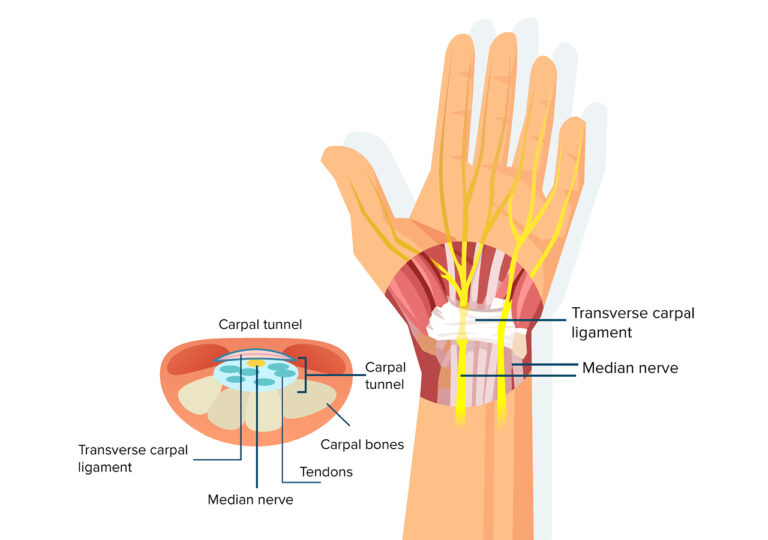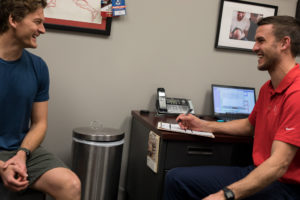Carpal tunnel syndrome is the result of irritation or pressure on the median nerve at the wrist. It is the most common compressive neuropathy of the upper extremity. Symptoms of carpal tunnel syndrome can be pain, numbness, and tingling in the wrist and hand.

The anatomical structure of the carpal tunnel is made up of your carpal bones (wrist bones), wrist muscle tendons, transverse carpal ligament, and the median nerve. Think of your wrist as a busy freeway on a commute home from work.
Another helpful analogy is to think of the transverse carpal ligament as an athlete with tape around their wrist that is too tight. The best way to get the tape to loosen is to move it (chiropractic/ physical therapy) or cut it (surgical intervention).
Chiropractic Approach To Carpal Tunnel Syndrome
Our sports chiropractic office treats carpal tunnel syndrome using various soft tissues mobilization techniques, at-home and in-office exercises, and chiropractic adjustments to the spine and extremities.
Key Findings of Carpal Tunnel Syndrome
- numbness, tingling, or weakness in your hand most commonly thumb, index, and middle finger
- Flick sign
- A hand that “falls asleep”
OMNE Chiropractic approach to carpal tunnel syndrome
- Rule out the neck or cervical spine
- Neurodynamic testing – how does your nerve respond to stretch and movement
- Work habits and stressors
- Neurological evaluation
Do you have Carpal Tunnel Syndrome?
Try these 3 At-Home tests to see if you may be suffering from Carpal Tunnel Syndrome.
1. Arm Elevation Test – symptoms are elicited or provoked with arm elevation in under 2 minutes. Place your arms overhead and monitor for pain. numbness, or tingling in the median nerve distribution.
2. Phalen Test – the backs of both hands are placed together with the fingers pointing down towards the ground. The position is held and a positive test is a reproduction of median nerve symptoms in under 1 minute
3. Flick Sign – patients describe flicking their hands and wrist to help relieve symptoms and bring feeling back to the hands. This is done after periods of inactivity such as sleeping or with prolonged positions or repetitive movement tasks.
Risk Factors for Carpal Tunnel Syndrome
- Age >45
- Female – CTS is more common in females
- Anatomical factors: Wrist Ratio Index, previous injury to the wrist, arthritis
- Obesity
- Body Fluid Changes – pregnancy and fluid retention make one more susceptible to CTS
- Workplace factors: vibrating tools, office work, and repetitive use activities
3 Exercises for Carpal Tunnel Syndrome
Our sports chiropractic clinic employs a movement-based approach to treating carpal tunnel syndrome. Promoting healthy movement of the wrist, forearm musculature, and median nerve helps decrease pressure and symptoms patients frequently experience. This is all done without the need for drugs or surgery!
1. Wrist Circle: movement of the wrist in circular motions helps promote movement and increase range of motion. Perform both clockwise and counterclockwise focusing on pushing into the stiff/sticky spots.
2. Self Myofascial Release: tension and tightness in the forearm musculature from extended use can cause irritation of the median nerve. Perform this myofascial release technique to the forearm musculature.
3. Median Nerve Glide: the gold standard for the treatment of carpal tunnel syndrome is median nerve glides. We can create movement and develop a healthier, more resilient nerve.
If you still have questions about our sports chiropractic approach to carpal tunnel syndrome, please don’t hesitate to reach out and make an appointment.




